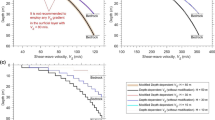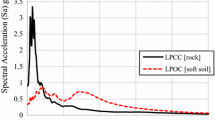Abstract
The effect of uncertainty on the shear wave velocity (VS) profiles from the Korean soil conditions on the seismic site response analysis (SRA) was investigated by comparing the amplification factors (AFs) computed from 170 VS profiles to those from three (representative) statistically derived VS profiles (Approach 1: a constant standard deviation of VS, σln(Vs), Approach 2: a depth-dependent, σln(Vs), and Approach 3: 5% and 95% percentiles for generating lower and upper bounds). All of the VS profiles are divided into three site classes (B, C, and D) by the National Earthquake Hazards Reduction Program (NHERP) site classification system. Seven pairs of ground motion records (two horizontal components) that represent Korean bedrock conditions are entered into all of the three types of VS profiles to run the SRA with a single type of modulus reduction and damping curves. The root-mean squared difference (RMSD) of the mean and standard deviation, (μln(AF), and σln(AF)) of the AFs in natural log-scale between the three types of VS profiles is estimated, which results in Approach 3 with the smallest RMSD measure for all the site classes. Conventionally, characterizing the uncertainty of the VS profiles is typically assessed through the representative profiles of Approach 1; however, this practice suggests that the inclusion of the percentile bounds (Approach 3) can be supplemental to better describe the VS uncertainty while taking the Approach 1 as primary representative profiles.
Similar content being viewed by others
References
Barani S, Ferrari RD, Ferretti G (2013) Influence of soil modeling uncertainties on site response. Earthquake Spectra 29(3):705–732, DOI: https://doi.org/10.1193/1.4000159
Bray JD, Travasarou T (2007) Simplified procedure for estimating earthquake-induced deviatoric slope displacements. Journal of Geotechnical and Geoenvironmental Engineering 133(4):381–392, DOI: https://doi.org/10.1061/(ASCE)1090-0241(2007)133;4(381)
Darendeli MB (2001) Development of a new family of normalized modulus reduction and material damping curves. PhD Thesis, The University of Texas, Austin, USA
EPRI (2013) Seismic evaluation guidance: Screening, prioritization and implementation details (SPID) for the resolution of Fukushima nearterm task force Recommendation 2.1: Seismic EPRI, Report 1025287, Palo Alto, California, USA
Griffiths SC, Cox BR, Rathje EM, Teague DP (2016) Surface-wave dispersion approach for evaluating statistical models that account for shear-wave velocity uncertainty. Journal of Geotechnical and Geoenvironmental Engineering 142(11):04016061, DOI: https://doi.org/10.1061/(ASCE)GT.1943-5606.0001552
Harmon J, Hashash YMA, Stewart JP, Rathje EM, Campbell KW, Silva WJ, Ilhan O (2016) Site amplification functions for Central and Eastern North America — Part II: Modular simulation-based models. Earthquake Spectra 35(2):815–847, DOI: https://doi.org/10.1193/091117EQS179M
Hashash YMA, Musgrove MI, Harmon JA, Ilhan O, Xing G, Numanoglu O, Groholski DR, Phillips CA, Park D (2020) DEEPSOIL 7.0, User Manual. Board of Trustees of University of Illinois at Urbana-Champaign, Urbana, IL, USA
Idriss IM (2004) Evolution of the state of practice, Int. Workshop on the Uncertainties in Nonlinear Soil Properties and Their Impact on Modeling Dynamic Soil Response. Pacific Earthquake Engineering Research Center, Richmond, California, USA
Li W, Assimaki D (2010) Site- and motion-dependent parametric uncertainty of site-response analyses in earthquake simulations. Bulletin of the Seismological Society of America 100(3):954–968, DOI: https://doi.org/10.1785/0120090030
Matasović N, Vucetic M (1993) Cyclic characterization of liquefiable sands. Journal of Geotechnical Engineering 119(11):1805–1822
Passeri F, Foti S, Cox BR, Rodriguez-Marek A (2019) Influence of epistemic uncertainty in shear wave velocity on seismic ground response analyses. Earthquake Spectra 35(2):929–954, DOI: https://doi.org/10.1193/011018EQS005M
Rathje EM, Kottke AR, Trent WL (2010) Influence of input motion and site property variabilities on seismic site response analysis. Journal of Geotechnical and Geoenvironmental Engineering 136(4):607–619, DOI: https://doi.org/10.1061/(ASCE)GT.1943-5606.0000255
Saygili G, Rathje EM (2008) Empirical predictive models for earthquake-induced sliding displacements of slopes. Journal of Geotechnical and Geoenvironmental Engineering 134(6):790–803, DOI: https://doi.org/10.1061/(ASCE)1090-0241(2008)134:6(790)
Toro GR (1995) Probabilistic models of site velocity profiles for generic and site-specific ground-motion amplification studies. Technical Report No. 779574
Acknowledgments
This work was supported by a National Research Foundation of Korea (NRF) grant funded by the Korean government (MSIT) (NRF-2020R1C1C1013317).
Author information
Authors and Affiliations
Corresponding author
Rights and permissions
About this article
Cite this article
Cho, Y., Jang, YE. & Kim, B. Influence of Uncertainty in Vs Profiles in the Southeastern Korea On Site Response Analyses. KSCE J Civ Eng 26, 4235–4241 (2022). https://doi.org/10.1007/s12205-022-1696-7
Received:
Accepted:
Published:
Issue Date:
DOI: https://doi.org/10.1007/s12205-022-1696-7




